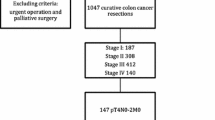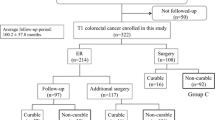Abstract
Purpose
The treatment of early-stage colorectal cancers removed endoscopically depends on histopathologic findings. This study aimed to assess the benefit–risk balance for patients who underwent additional surgery after endoscopic resection of a T1 carcinoma with unfavorable histology.
Methods
From 2000 to 2010, 64 consecutive patients were included in this retrospective study. Specimens resected after endoscopic polypectomy showed at least one of the following unfavorable factors: no free margin, lymphovascular invasion, poorly differentiated grade, SM2–3 involvement (submucosal invasion greater than 300 μm from the muscularis mucosae), tumor budding, sessile morphology, and piecemeal resection. The main objective was to assess the benefit–risk balance of an oncological resection performed after the polypectomy. Oncological benefit was measured by the lymph node metastasis rate and the persistence of a residual adenocarcinoma on the specimen. The risk was measured by the occurrence of severe complications of grade III–IV or death. The associations between these end points and clinicopathologic variables were evaluated by univariate analysis and logistic regression.
Results
Five patients (7.8 %) had lymph node metastases and two (3.1 %) had residual carcinomas. Eight patients (12.5 %) had grade III–IV morbidity. There were no deaths. Oncological benefit was associated by logistic regression analysis with patients who presented multiple criteria (≥2) that led to surgery (p = 0.031). The benefit–risk balance was favorable only for those patients.
Conclusions
Additional surgery is required for patients who present multiple adverse histological criteria. If only one criterion is selected, the indication should be discussed, especially for patients with multiple comorbidities.
Similar content being viewed by others
References
Colacchio TA, Forde KA, Scantlebury VP (1981) Endoscopic polypectomy: inadequate treatment for invasive colorectal carcinoma. Ann Surg 194:704–707
Bujanda L, Cosme A, Gil I, Arenas-Mirave JI (2010) Malignant colorectal polyps. World J Gastroenterol 16:3103–3111. doi:10.3748/wjg.v16.i25.3103
Haggitt RC, Glotzbach RE, Soffer EE, Wruble LD (1985) Prognostic factors in colorectal carcinomas arising in adenomas: implications for lesions removed by endoscopic polypectomy. Gastroenterology 89:328–336
Kikuchi R, Takano M, Takagi K, Fujimoto N, Nozaki R, Fujyyoshi T, Uchida Y (1995) Management of early invasive colorectal cancer. Risk of recurrence and clinical guidelines. Dis Colon Rectum 38:1286–1295. doi:10.1007/BF02049154
Tytherleigh MG, Warren BF, Mortensen NJ (2008) Management of early rectal cancer. Br J Surg 95:409–423. doi:10.1002/bjs.6127
Nakagoe T, Sawai T, Tsuji T et al (2004) Additional radical surgery after colonoscopic snare polypectomy for T1 colorectal cancer: use of the minilaparotomy approach. Int Surg 89:10–14
Cooper GS, Xu F, Barnholtz Sloan JS, Kouroukian SM, Schluchter MD (2011) Management of malignant colonic polyps: a population-based analysis of colonoscopic polypectomy versus surgery. Cancer. doi:10.1002/cncr.26340
Boenicke L, Fein M, Sailer M, Isbert C, Germer CT, Thalheimer A (2010) The concurrence of histologically positive resection margins and sessile morphology is an important risk factor for lymph node metastasis after complete endoscopic removal of malignant colorectal polyps. Int J Colorectal Dis 25:433–438. doi:10.1007/s00384-009-0836-6
Ueno H, Mochizuki H, Hashiguchi Y et al (2004) Risk factors for an adverse outcome in early invasive colorectal carcinoma. Gastroenterology 127:385–394. doi:10.1053/j.gastro.2004.04.022
Cooper HS, Deppisch LM, Gourley WK et al (1995) Endoscopically removed malignant colorectal polyps: clinico-pathologic correlations. Gastroenterology 108:1657–1665
Homma Y, Hamano T, Otsuki Y, Shimizu S, Kobayashi H, Kobayashi Y (2010) Severe tumor budding is a risk factor for lateral lymph node metastasis in early rectal cancer. J Surg Oncol 102:230–234. doi:10.1002/jso.21606
Hase K, Shatney C, Johnson D, Trollope M, Vierra M (1993) Prognostic value of tumor “budding” in patients with colorectal cancer. Dis Colon Rectum 36:627–635. doi:10.1007/BF02238588
Doniec JM, Löhnert MS, Schniewind B, Bokelmann F, Kremer B, Grimm H (2003) Endoscopic removal of large colorectal polyps: prevention of unnecessary surgery? Dis Colon Rectum 46:340–348. doi:10.1007/s10350-004-6553-x
Dindo D, Demartine N, Clavien PA (2004) Classification of surgical complications: a new proposal with evaluation in a cohort of 6336 patients and results of a survey. Ann Surg 240:205–213. doi:10.1097/01.sla.0000133083.54934.ae
Volk EE, Goldbleum JR, Petras RE, Carey WD, Fazio VW (1995) Management and outcome of patients with invasive carcinoma arising in colorectal polyps. Gastroenterology 109:1801–1807
Whitlow C, Gathright JB Jr, Hebert SJ et al (1997) Long-term survival after treatment of malignant colorectal polyps. Dis Colon Rectum 40:929–934. doi:10.1007/BF02051200
Kyzer S, Bégin LR, Gordon PH, Mitmaker B (1992) The care of patients with colorectal polyps that contain invasive adenocarcinoma. Endoscopic polypectomy or colectomy? Cancer 70:2044–2050. doi:10.1002/1097-0142(19921015)70
Nivatvongs S, Rojanasakul A, Reiman HM et al (1991) The risk of lymph node metastasis in colorectal polyps with invasive adenocarcinoma. Dis Colon Rectum 34:323–328
Nelson H, Petrelli N, Carlin A et al (2001) Guidelines 2000 for colon and rectal cancer surgery. J Natl Cancer Inst 93:583–596. doi:10.1093/jnci/93.8.583
Maggard MA, Yermilov I, Tomlinson JS, Ko CY (2009) Are 12 nodes needed to accurately stage T1 and T2 colon cancers. Dig Dis Sci 54:640–647. doi:10.1007/s10620-008-0373-0
Bokey EL, Chapuis PH, Fung C et al (1995) Postoperative morbidity and mortality following resection of the colon and rectum for cancer. Dis Colon Rectum 38:480–486
Cahill RA, Bembenek A, Sirop S et al (2009) Sentinel node biopsy for the individualization of surgical strategy for cure of early-stage colon cancer. Ann Surg Oncol 16:2170–2180. doi:10.1245/s10434-009-0510-9
Acknowledgments
The authors thank Mr. B Collins for his writing assistance.
Author information
Authors and Affiliations
Corresponding author
Rights and permissions
About this article
Cite this article
Benizri, E.I., Bereder, JM., Rahili, A. et al. Additional colectomy after colonoscopic polypectomy for T1 colon cancer: a fine balance between oncologic benefit and operative risk. Int J Colorectal Dis 27, 1473–1478 (2012). https://doi.org/10.1007/s00384-012-1464-0
Accepted:
Published:
Issue Date:
DOI: https://doi.org/10.1007/s00384-012-1464-0




